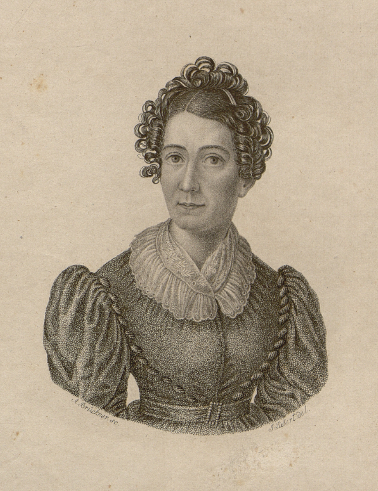Amalia Schoppe

If Amalia Schoppe is mentioned in the current textbooks of literary history, it is as a rule only in connection with the young Friedrich Hebbel, to whom she gave material support in the 1830s and whom she helped on the road to literary success. She herself is barely perceived there as an author. Schoppe is, meanwhile, one of Germany’s most productive and well-known female authors of the first half of the 19th century. The list of her independent literary publications comprises almost 130 volumes, to which are added editorships of literary magazines as well as countless articles in anthologies, almanacs and other contemporary periodicals. Her texts have been translated into French, English, Dutch and Czech. As time passed, after her emigration to the USA and her death there she largely sank into oblivion.
Amalia Schoppe was born on October 9th, 1791, in Burg, on the island of Fehmarn. Her parents were the district doctor Johann Friedrich Wilhelm Weise (1769–1798) and his wife Angelica Catharina, née Hammer and, since 1803, Burmester. From them Amalia receives her first lesson in reading and writing. After her father’s early death she moves to the house of her uncle, Pastor Johann Heinrich Hammer, in Hamburg. There she is granted an education and further training (among other things, in French) that are marked by strictness. Due to the family’s impoverishment in the course of the Napoleonic Wars, Amalia, a girl of fifteen, is already forced to earn her own living: she takes a position as educator at the house of the patrician Jacob Amsel Oppenheimer of Hamburg. In the summer of 1808 she meets Rosa Maria Varnhagen, later Assing. A conversation about Novalis, Schleiermacher, Goethe “and the better ones in general” marks the beginning of a lifelong friendship. The young Varnhagen recognizes in her new friend a “deep soul and a beautiful, inner religiosity” and brings her, mainly through letters, into her circle of friends and acquaintances. These are, besides Karl August Varnhagen von Ense (Rosa Maria’s brother), first Adelbert von Chamisso, Friedrich de la Motte Fouqué and Justinus Kerner. To Justinus Kerner, Rosa Maria Varhhagen sends some of her friend’s poems and thereby arranges her literary debut in the “Poetischen Almanach für das Jahr 1812”, published by Kerner. Weise, later Schoppe, will publish her poems in the 1810s practically anonymously—using only her first name—in, among others, the “Morgenblatt für gebildete Stände”, the “Zeitung für die elegante Welt”, the “Gesellschafter” and other literary magazines.
Since ca. 1812, she has a relationship with Heinrich Schuppe (since 1817, Schoppe), a budding lawyer from Hamburg (1787–1829). With him she conceives the illegitimate son Carl Adalbert. Two more sons spring from of the time between their marriage in 1814 and divorce in 1821: Carl Julius (1818–1847) and Alphons (1821–1865). To take care of herself and her children, Schoppe initially leads a school at Fehmarn for the local children. After moving to Wandsbek near Hamburg she founds a girls’ boarding school with Fanny Tarnow. With her new friend, she also publishes the volume “Erzählungen und Romane” (1820), which meets with broad approval and helps Schoppe to her breakthrough into the literary market. The educational undertaking runs aground due to a number of tensions and differences of opinion. From the acquaintance with Fanny Tarnow, however, new contacts and perspectives arise. Schoppe feels above all encouraged to more intensively come out as an author and publisher. Literary production gradually becomes for her a profession and, at the same time, her most important means of subsistence. She establishes contacts with respected authors such as Helmina von Chézy, Therese Huber, Caroline von Wolzogen and later Friederike (Lina) Reinhardt, as well as with the publishers August Taubert and Carl Focke from Leipzig. Since the early 1820s, she publishes an astonishing amount of material—at first under different pseudonyms and later ever more frequently under her own name. With her stories, novels, libretti, plays and adaptations of Spanish, English and French literature, she tries to reach especially young and female audiences. She creates her subject matter from history, biographies, legends, sagas and foreign-language literature. To that are added countless journalistic texts in the most important periodicals of the time, especially reviews and reports on the cultural landscape of Hamburg. As publisher she is (co)responsible, moreover, for the magazines “Neue Pariser Modeblätter” (1827–1845), “Iduna” (1831–1839) and “Berliner Modenspiegel” (1846–1847), among others. Schoppe spends most of her life in the north of Germany: Fehmarn and Hamburg. She also lives for a short period in Jena, from 1842 to 1845. After a series of difficult circumstances she decides to leave Germany and moves to the USA in 1851. There she tries to help her youngest and only surviving son to live independently. From the USA she continues to write reports for the German press for a time and, in addition, maintains mail correspondence with Ludmilla and Ottilie Assing and with Karl August Varnhagen von Ense. Amalia Schoppe dies in 1858 after suffering a stroke, being buried in Schenectady in the state of New York. If she is dismissed in literary history as a marginal figure and an author of pulp fiction, quite a different picture is painted on the basis of her extant manuscripts, mainly in the Varnhagen Collection—namely, the picture of a woman fighting for independence and emancipation, who seeks to overcome ill-treatment, violence, hard blows of fate and financial misery.
(trans. Pedro Kauffmann Amaral)

Literatur
Lorely French:
„Amalia Schoppe (1791–1858). ‚Die Arbeit ist aber Freude und Gewohnheit für mich.’“. In: Vom Salon zur Barrikade. Frauen der Heinezeit. Hrsg. von Irina Hundt.
Stuttgart u. a. 2002, S. 129–142.
Amalia Schoppe:
Erinnerungen aus meinem Leben, in kleinen Bildern. 2 Teile.
Altona: Johann Friedrich Hammerich 1838.
Hargen Thomsen (Hrsg.):
„…das wunderbarste Wesen, so ich je sah“. Amalie Schoppe. Eine Schriftstellerin des Biedermeier (1791–1858) in Briefen und Schriften.
Bielefeld 2008.